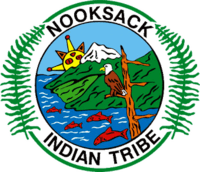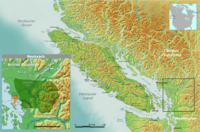Nooksack people facts for kids

Clockwise from top: Koma Kulshan, bald eagle, Chinook salmon, Georgia Strait; supporters: sword ferns
|
|
 |
|
| Total population | |
|---|---|
| 1,800 | |
| Regions with significant populations | |
| Whatcom County | |
| Languages | |
| English, Nooksack | |
| Religion | |
| American Indian pantheism, Christianity, other | |
| Related ethnic groups | |
| other Coast Salish peoples |
The Nooksack (pronounced NOOK-sack) are a Native American tribe. They are officially recognized by the United States government. This means they are a "sovereign nation," which is like being their own small country with their own laws.
The Nooksack live in the northwest corner of Washington state. Their land is along the Nooksack River, near the town of Deming. This area is about 12 miles south of the border with Canada. In 2008, there were more than 1,800 members in the Nooksack tribe. To be a member, a person must be a descendant of someone listed in a tribal count from 1942.
The Nooksack people are part of the larger Coast Salish group. They traditionally spoke the Nooksack language. This language is part of the Salishan language family. It is very similar to the Halkomelem language spoken in British Columbia, Canada. Long ago, some even thought Nooksack was a dialect of Halkomelem. When Europeans first arrived, the Nooksack people lived in areas that are now both in Washington state and British Columbia. The border between Canada and the United States later divided their traditional lands.
Contents
Nooksack History and Land
Like many Native American groups in the Pacific Northwest, the Nooksack people traditionally lived near rivers and the coast. They relied on fishing, hunting, and gathering food. This included catching salmon, hunting animals, collecting clams, and finding root vegetables and berries. They would also prepare and store this food to last through the year.
Their traditional territory stretched from the mountains to the coast. It followed the Nooksack River watershed in what is now northwest Washington state. It also extended into British Columbia, Canada. The Nooksack people would set up temporary camps for hunting or fishing. For example, they timed their camps to harvest salmon when the fish were plentiful.
When Europeans explored and settled the Pacific Northwest, it brought big changes. Many Nooksack people became sick from new diseases. They also lost access to much of their traditional land. The Nooksack people who survived continued to live near the river that gives them their name.
Becoming a Recognized Tribe
In 1934, the U.S. government passed a law called the Indian Reorganization Act. This law aimed to help Native American tribes regain their self-government. Many tribes had lost this right, especially on reservations. However, the Nooksack people had not been given reservation land by the U.S. government in the 1800s. Because of this, the government did not officially recognize them as a tribe at that time.
In the 1930s, the Nooksack tribe decided to accept the Indian Reorganization Act. They started to create their own tribal constitution. This constitution would set up an elected government for their people. In 1942, they took a census (a count) of everyone considered a member of their community. Their constitution also allowed for other ways to prove tribal identity.
For many years, the Nooksack people worked hard to organize their community. They wanted to gain official recognition from the federal government. During this time, many Nooksack and other Coast Salish people moved away from Whatcom County. They went to the Puget Sound area, where there were more jobs.
The Nooksack tribe finally bought a small piece of land (about one acre) in 1970. This land became their reservation. In 1973, they gained full federal recognition as a tribe. The U.S. government now holds much of their land "in trust" for them. This means the government manages the land for the tribe's benefit. Today, the Nooksack's land base has grown to over 3,100 acres. This includes land they own directly and land held in trust. Trust land is where the tribe has its own government and laws.
In the 1970s, important court decisions, like the Boldt decision, helped Native Americans in Washington state. These decisions confirmed their rights to fish and gather food in their traditional ways on their historic lands.
Nooksack Tribal Government
The Nooksack tribe created a constitution that set up an elected government. This was based on the model suggested by the Indian Reorganization Act.
Under their constitution, tribal members vote for representatives to an 8-person council. Half of these positions are elected every two years. The tribal chairman, vice-chairman, treasurer, and secretary are all elected as part of this council. Everyone on the council serves for two years. The tribal council is in charge of approving policies and passing laws for the tribe.
The Nooksack tribe also has its own court system, called a tribal court. This court helps resolve legal issues within the tribe.
Tribal Membership Rules
The Nooksack tribe has specific rules for who can be a member. These rules state that members include:
- People who received early land shares.
- People who received money from a government settlement in 1965.
- People who were listed in the 1942 tribal census.
- And their direct descendants.
The Nooksack constitution also used to allow people to join if they had at least one-quarter Native American blood and could prove Nooksack ancestry. However, in 2014, the tribe voted to remove this rule from their constitution.
Nooksack Population and Language
According to the 2000 census, the Nooksack Indian Reservation had 547 people living on it. This area covers about 2,720 acres. Of these residents, 373 people, or about 68%, identified as being solely of Native American ancestry.
Nooksack Language Today
The Nooksack language, also called Lhéchalosem, is part of the Salishan family. It is most similar to the Halkomelem language from British Columbia. For a long time, Halkomelem was the main Native American language spoken by the Nooksack people in the United States. This shows how closely related the people were on both sides of the border.
Sadly, by 2016, the last person who spoke Nooksack fluently was George Adams, an elder of the tribe. In the late 1900s, some people thought the language had died out around 1988. In the 1970s, an American linguist named Brent Galloway worked with another fluent speaker. He tried to create a dictionary of the Nooksack language. However, it's not clear if his work was published before he passed away. Galloway's book, Dictionary of Upriver Halkomelem (published in 2009), covers a language from the same area but it is different from the Nooksack language.
Images for kids


